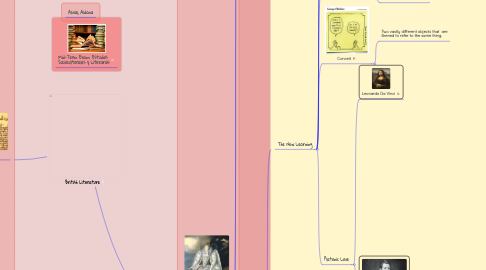
1. The Medieval Period
1.1. Narrative Poems
1.1.1. Tell a story
1.1.2. Accompanied by music instruments
1.1.3. Implicit or explicit moral
1.1.4. Include characters, plot, conflict and resolution, setting and action.
1.1.5. Narrative poems include old epics, romances, lays and ballads.
1.1.6. Breton Lay
1.1.6.1. Sir Orfeo
1.1.6.1.1. The story is based on a myth
1.1.6.1.2. Setting
1.1.6.1.3. Topics
1.1.6.1.4. Characters
1.1.6.1.5. Supernatural Events
1.1.6.1.6. Importance of the forest
1.1.6.2. Drawn from Arthurian and other Celtic Legends
1.1.6.2.1. Music sacred by the Celts. It represents harmony.
1.1.7. Ballads
1.1.7.1. Unknown author
1.1.7.2. Transmitted orally from generation to generation
1.1.7.3. Sung by illiterate or partly literate people
1.1.7.4. Topics
1.1.7.4.1. Tragic accidents and sudden disasters
1.1.7.4.2. Jealousy and unrequited love
1.1.7.5. Little attention to characterisation
1.1.7.6. Simple Stanzas
1.1.7.7. Usually based on actual events
1.1.7.8. Techniques
1.1.7.8.1. Descriptive phrases
1.1.7.8.2. A refrain in each stanza
1.1.7.8.3. Incremental repetition
1.1.7.9. Relevant Texts
1.1.7.9.1. Sir Patrick Spens
1.1.7.9.2. St. Stephen and King Herod
1.1.7.9.3. Get up and bar the door
1.1.7.9.4. The Two Sisters of Binnorie
1.1.7.9.5. The Wife of Usher´s Well
1.1.7.9.6. Bonny Barbara Allan
1.1.7.9.7. Lord Randal
1.1.7.9.8. Child Maurice
1.1.7.9.9. Fair Margaret and sweet william
1.1.7.9.10. The Wraggle Taggle Gipsis
1.1.7.10. Baladeers
1.1.7.10.1. The ones who sung the ballads
1.1.7.10.2. The Lute - The Bebec
1.1.7.11. Broadside Balladas
1.1.7.11.1. Written on one side of a single sheet
1.1.7.11.2. Deal with current events, people or issues
1.1.8. Epic
1.1.8.1. Long, serious poem - tells the story of a heroic figure
1.1.9. Romance
1.1.9.1. Long narrative poetry about courtly culture and secret love
1.1.10. FABLES
1.1.10.1. ANIMALS AS MAIN CHARACTER
1.1.11. FABLIAUX
1.1.11.1. TONE REALISTIC, HUMOROUS, OFTEN SEXUAL
1.1.11.1.1. OPPOSITE OF COURTLY LOVE
1.2. Lyric Poems
1.2.1. Similar to a Song
1.2.2. Expression of feelings and emotions
1.2.3. The Lyre is used to play the poem
1.2.4. First person character
1.2.5. Lyric forms
1.2.5.1. Sonnet
1.2.5.1.1. 14 lines long
1.2.5.2. Ode
1.2.5.2.1. A long poem serious in nature
1.2.5.2.2. A tribute to a person, place sentiment or thing
1.2.5.3. Haiku
1.2.5.3.1. A Japanese poem
1.2.5.3.2. Unrhymed lines of five, seven, and five syllables
1.2.5.3.3. Often based on an image
2. Mid-Term Exam: Estudios Socioculturales y Literarios
3. Alvial, Aldana
4. The Renaissance
4.1. Rebirth - Revival
4.2. 17th Century - England
4.2.1. Elizabethan Era
4.2.1.1. Public Theatre - The Queen went to see the play
4.3. Changes
4.3.1. The New Learning
4.3.1.1. The invention of printing on paper
4.3.1.1.1. Spread of ideas
4.3.1.2. Renaissance Man
4.3.1.2.1. Physical, intellectual, artistic skills, warrior and stateman
4.3.1.3. Humanism:
4.3.1.3.1. The relationship between man and God was re-examined
4.3.1.4. Changes in pronunciation
4.3.1.4.1. The Great vowel shift
4.3.1.5. Conceit
4.3.1.5.1. Two vastly different objects that are likened to refer to the same thing.
4.3.1.6. Platonic Love
4.3.1.6.1. Leonardo Da Vinci
4.3.1.6.2. Sir Philip Sidney
4.3.2. Religion
4.3.2.1. Martin Luther
4.3.2.1.1. FATHER OF REFORFMATION
4.3.2.2. Henry VIII
4.3.2.2.1. Ended the rule of the Catholic Church
4.3.3. The New World
4.3.3.1. The Discovery of the New World
4.3.4. The New Cosmos
4.3.4.1. Copernican Theory
4.3.4.1.1. The center is the sun
4.3.4.1.2. The Earth is not stationary
4.3.5. The New Science
4.3.5.1. Kepler
4.3.5.2. Galileo
4.3.5.3. Harvey
4.3.5.3.1. The circulation of the blood (1628)
4.3.5.4. Descartes
4.3.5.5. Clocks, telescopes, microscopes and compasses
